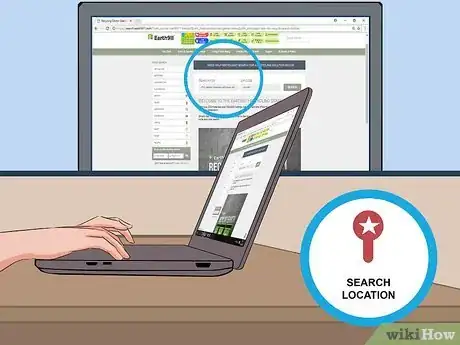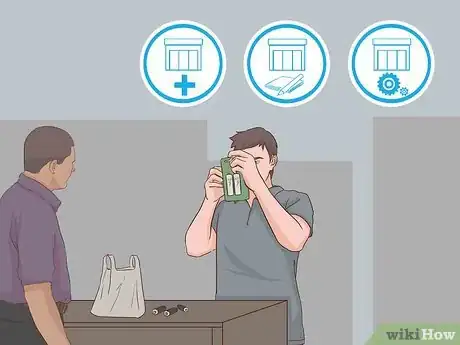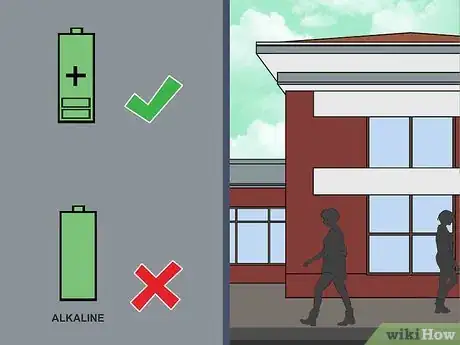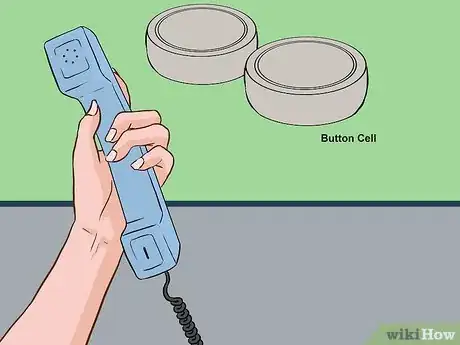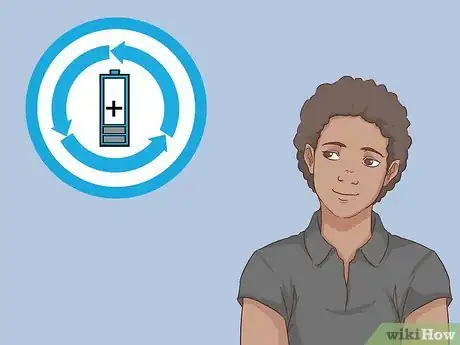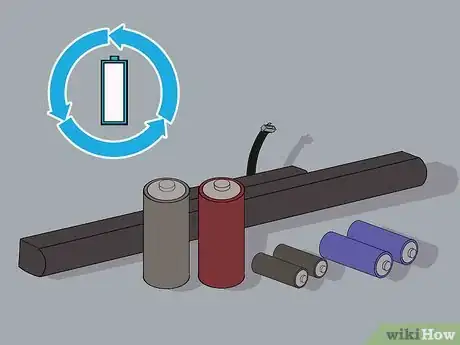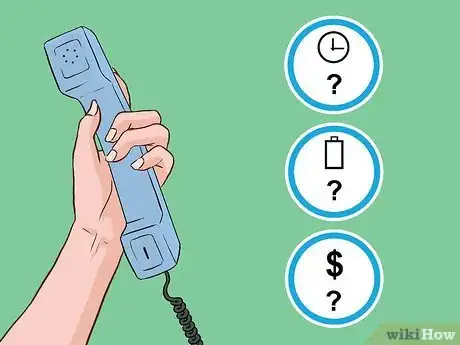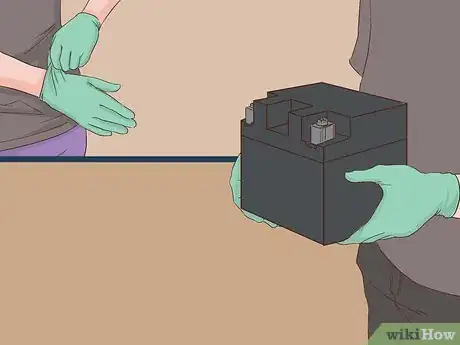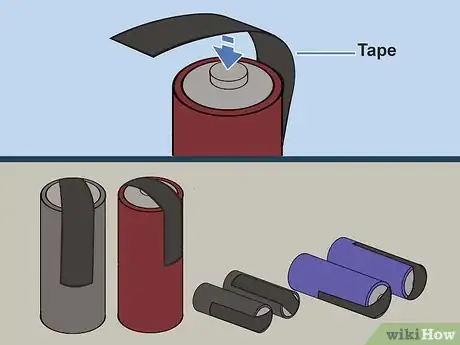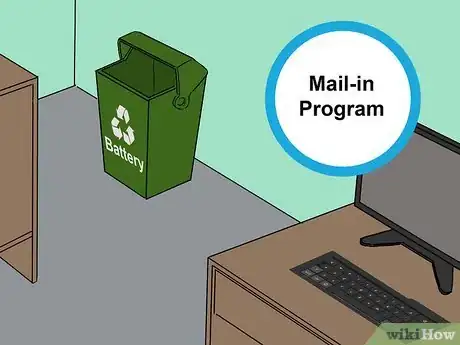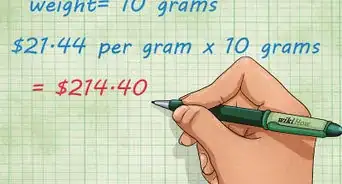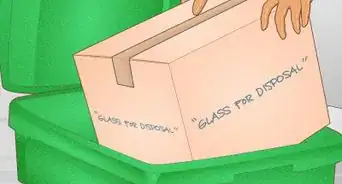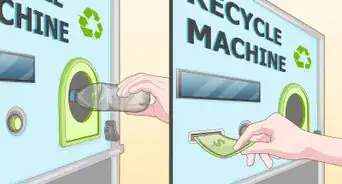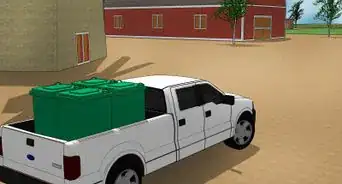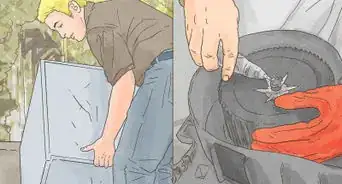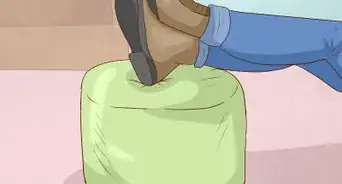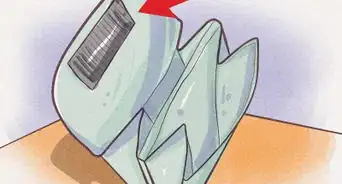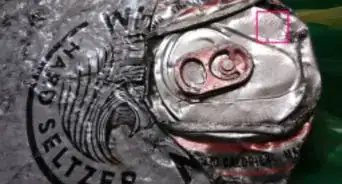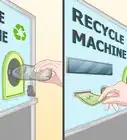This article was co-authored by Kathryn Kellogg. Kathryn Kellogg is the founder of goingzerowaste.com, a lifestyle website dedicated to breaking eco-friendly living down into a simple step-by-step process with lots of positivity and love. She's the author of 101 Ways to Go Zero Waste and spokesperson for plastic-free living for National Geographic.
This article has been viewed 41,020 times.
Recycling single-use batteries is an easy way to make the world a little greener. Every battery contains some reusable material, whether rechargeable or single-use. You can either take your batteries into a local store or recycling facility, or you can mail them to a facility through a mail-in program. When you recycle your batteries, you help reduce soil contamination and water pollution, so keep recycling and making the world a better place!
Steps
Finding Recycling Centers and Programs
-
1Find a local facility by checking an online facility locator. This is the easiest way to find the closest recycling facility. Once you’ve found a convenient location, gather up your batteries and drop them off at the facility. To find your closest battery recycling facility, simply enter your zipcode into this locator: https://earth911.com/recycling-guide/how-to-recycle-single-use-batteries/.
- Many recycling locators will also let you browse locations by battery type, which makes the process much easier.
-
2Ask stores if they participate in Call2Recycle to drop off rechargeables. Call2Recycle is a battery recycling program used across North America. Although not every state is required to follow battery recycling regulations, the ones that are required to usually have stores that collect used batteries, such as pharmacies, office supply stores, or hardware stores.
- For a map of which states follow recycling laws, go to: https://www.call2recycle.org/recycling-laws-by-state/.
- You can find businesses that participate in Call2Recycle or sign up as a collection center by visiting http://www.call2recycle.org/4-simple-steps-to-recycling/.
Advertisement -
3Look for battery collection sites at chain stores. Companies like IKEA and Best Buy have made a commitment to recycling batteries, and you can usually find a drop-off station in stores. However, always check which types of batteries they accept before you take your batteries in.[1]
- For example, Best Buy collection sites only accept rechargeables, not alkaline batteries.
-
4Contact the manufacturer to return a button cell battery. These batteries are often used in hearing aids and watches. Manufacturers sometimes offer battery-returning programs to customers, so make sure to contact the company and ask if they have a program.
- If the manufacturer doesn’t have a take-back program, you can also recycle button cell batteries at certain jewelry, watch repair, and camera stores. Call the company ahead of time to verify that they’re able to take your batteries.
-
5Expect to find more recycling programs for rechargeable batteries. It’s generally easier to recycle rechargeable batteries than single-use batteries because they contain valuable metals that companies want to collect, such as mercury, silver, and aluminium. This category of battery includes lithium-ion, nickel-metal hydride, nickel-zinc, and silver-oxide batteries.
- These batteries are found in portable electronics, hybrid cars, hearing aids, watches, and calculators.
-
6Keep in mind that recycling single-use batteries may cost a small fee. This category of battery, which includes alkaline and lithium batteries, has a more limited recycling market. Although they contain a number of recyclable materials, they don’t contain any valuable heavy metals. You may have to pay a small fee for recycling them, so make sure to call in ahead of time and check.[2]
- These batteries are often found in common household items like cordless power tools, laptop computers, digital cameras, and remotes.[3]
Taking or Mailing in Your Batteries
-
1Call ahead and confirm the details with the recycling location. Before you bring your batteries in, make sure to call the facility for information on their hours, which types of batteries they take, and whether or not they charge a fee. This will help you save time and energy![4]
-
2Wear gloves and don’t touch the ends when handling old batteries. Always be careful when you’re preparing to recycle old batteries. In case of any leaked acid or leftover charge, always handle them with latex gloves and avoid touching the ends, where the terminals are located.
-
3Bag or tape the tops of non-alkaline batteries before recycling. The batteries may still have a bit of charge left, so it’s important to separate the terminals, where the charge comes out of. To do this, you can either place each battery in a separate plastic bag or place a piece of clear tape over the terminal, or the small bump, on the top of the battery.
- If 2 battery ends touch, the tape will help prevent sparking and lower fire risk.[5]
- Do not use opaque tape on the battery ends.
- Do not bag or tape any single-use alkaline batteries.
-
4Set up a battery mail-in program in your office. Join a mail-in program and place a bucket or bin in the office mail-room. Have all of the employees tape and collect their dry-cell batteries in the bin, then mail them off once the container is full.[6]
- The fee for a mail-in program is usually a flat rate of around $60 per load, which lets you send in a large amount of batteries. Prices may vary depending on the type of battery you’re sending in.
Expert Q&A
-
QuestionHow do you properly dispose of batteries?
 Kathryn KelloggKathryn Kellogg is the founder of goingzerowaste.com, a lifestyle website dedicated to breaking eco-friendly living down into a simple step-by-step process with lots of positivity and love. She's the author of 101 Ways to Go Zero Waste and spokesperson for plastic-free living for National Geographic.
Kathryn KelloggKathryn Kellogg is the founder of goingzerowaste.com, a lifestyle website dedicated to breaking eco-friendly living down into a simple step-by-step process with lots of positivity and love. She's the author of 101 Ways to Go Zero Waste and spokesperson for plastic-free living for National Geographic.
Sustainability Specialist Always turn your batteries in for battery recycling. If you put them in your recycling bin, the batteries can explode in the compactor bin and injure workers. Also, if they're in a landfill, the chemicals can leach out into the groundwater and soil.
Always turn your batteries in for battery recycling. If you put them in your recycling bin, the batteries can explode in the compactor bin and injure workers. Also, if they're in a landfill, the chemicals can leach out into the groundwater and soil. -
QuestionWhere can I recycle household batteries in my area?
 Kathryn KelloggKathryn Kellogg is the founder of goingzerowaste.com, a lifestyle website dedicated to breaking eco-friendly living down into a simple step-by-step process with lots of positivity and love. She's the author of 101 Ways to Go Zero Waste and spokesperson for plastic-free living for National Geographic.
Kathryn KelloggKathryn Kellogg is the founder of goingzerowaste.com, a lifestyle website dedicated to breaking eco-friendly living down into a simple step-by-step process with lots of positivity and love. She's the author of 101 Ways to Go Zero Waste and spokesperson for plastic-free living for National Geographic.
Sustainability Specialist Stores like Target and BestBuy typically have battery recycling bins at the front of the store.
Stores like Target and BestBuy typically have battery recycling bins at the front of the store.
References
- ↑ https://recyclenation.com/2014/03/recycle-alkaline-batteries/
- ↑ http://ewaste.ee.washington.edu/consumers/battery-recycling/
- ↑ https://www.ehso.com/batteries.php
- ↑ http://ewaste.ee.washington.edu/consumers/battery-recycling/
- ↑ http://www.businessinsider.com/how-to-recycle-batteries-2015-10
- ↑ https://earth911.com/recycling-guide/how-to-recycle-single-use-batteries/
About This Article
The best way to recycle batteries is through a recycling program, and you can locate facilities by looking them up online. In North America, call your local pharmacy, office supply store, or hardware store to ask if they participate in Call2Recycle, and drop off your batteries there if they do. Sometimes, stores like IKEA and electronics stores will have battery drop-off stations for collecting batteries to be recycled. Be sure to ask beforehand if recycling your batteries will cost anything, especially if the batteries aren’t rechargeable. If you want to learn more, such as safety precautions to take before recycling the batteries, keep reading the article!
